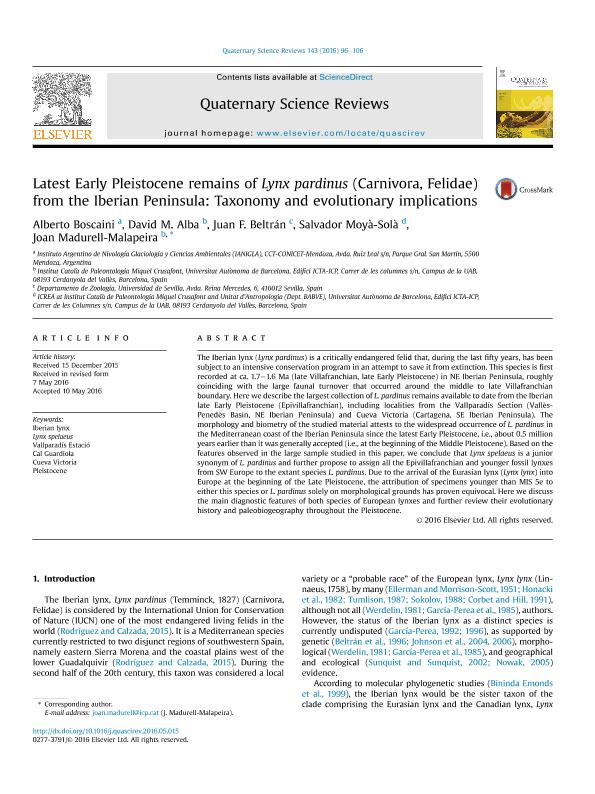Mostrar el registro sencillo del ítem
dc.contributor.author
Boscaini, Alberto

dc.contributor.author
Alba, David M.
dc.contributor.author
Beltrán, Juan F.
dc.contributor.author
Moyà Solà, Salvador
dc.contributor.author
Madurell Malapeira, Joan
dc.date.available
2023-01-02T18:55:35Z
dc.date.issued
2016-07
dc.identifier.citation
Boscaini, Alberto; Alba, David M.; Beltrán, Juan F.; Moyà Solà, Salvador; Madurell Malapeira, Joan; Latest Early Pleistocene remains of Lynx pardinus (Carnivora, Felidae) from the Iberian Peninsula: Taxonomy and evolutionary implications; Pergamon-Elsevier Science Ltd; Quaternary Science Reviews; 143; 7-2016; 96-106
dc.identifier.issn
0277-3791
dc.identifier.uri
http://hdl.handle.net/11336/182970
dc.description.abstract
The Iberian lynx (Lynx pardinus) is a critically endangered felid that, during the last fifty years, has been subject to an intensive conservation program in an attempt to save it from extinction. This species is first recorded at ca. 1.7-1.6 Ma (late Villafranchian, late Early Pleistocene) in NE Iberian Peninsula, roughly coinciding with the large faunal turnover that occurred around the middle to late Villafranchian boundary. Here we describe the largest collection of L. pardinus remains available to date from the Iberian late Early Pleistocene (Epivillafranchian), including localities from the Vallparadís Section (Vallès-Penedès Basin, NE Iberian Peninsula) and Cueva Victoria (Cartagena, SE Iberian Peninsula). The morphology and biometry of the studied material attests to the widespread occurrence of L. pardinus in the Mediterranean coast of the Iberian Peninsula since the latest Early Pleistocene, i.e., about 0.5 million years earlier than it was generally accepted (i.e., at the beginning of the Middle Pleistocene). Based on the features observed in the large sample studied in this paper, we conclude that Lynx spelaeus is a junior synonym of L. pardinus and further propose to assign all the Epivillafranchian and younger fossil lynxes from SW Europe to the extant species L. pardinus. Due to the arrival of the Eurasian lynx (Lynx lynx) into Europe at the beginning of the Late Pleistocene, the attribution of specimens younger than MIS 5e to either this species or L. pardinus solely on morphological grounds has proven equivocal. Here we discuss the main diagnostic features of both species of European lynxes and further review their evolutionary history and paleobiogeography throughout the Pleistocene.
dc.format
application/pdf
dc.language.iso
eng
dc.publisher
Pergamon-Elsevier Science Ltd

dc.rights
info:eu-repo/semantics/openAccess
dc.rights.uri
https://creativecommons.org/licenses/by-nc-nd/2.5/ar/
dc.subject
CAL GUARDIOLA
dc.subject
CUEVA VICTORIA
dc.subject
IBERIAN LYNX
dc.subject
LYNX SPELAEUS
dc.subject
PLEISTOCENE
dc.subject
VALLPARADÍS ESTACIÓ
dc.subject.classification
Paleontología

dc.subject.classification
Ciencias de la Tierra y relacionadas con el Medio Ambiente

dc.subject.classification
CIENCIAS NATURALES Y EXACTAS

dc.title
Latest Early Pleistocene remains of Lynx pardinus (Carnivora, Felidae) from the Iberian Peninsula: Taxonomy and evolutionary implications
dc.type
info:eu-repo/semantics/article
dc.type
info:ar-repo/semantics/artículo
dc.type
info:eu-repo/semantics/publishedVersion
dc.date.updated
2022-12-27T18:15:51Z
dc.journal.volume
143
dc.journal.pagination
96-106
dc.journal.pais
Países Bajos

dc.journal.ciudad
Amsterdam
dc.description.fil
Fil: Boscaini, Alberto. Consejo Nacional de Investigaciones Científicas y Técnicas. Centro Científico Tecnológico Conicet - Mendoza. Instituto Argentino de Nivología, Glaciología y Ciencias Ambientales. Provincia de Mendoza. Instituto Argentino de Nivología, Glaciología y Ciencias Ambientales. Universidad Nacional de Cuyo. Instituto Argentino de Nivología, Glaciología y Ciencias Ambientales; Argentina
dc.description.fil
Fil: Alba, David M.. Universitat Autònoma de Barcelona; España. Institut Català de Paleontologia Miquel Crusafont; España
dc.description.fil
Fil: Beltrán, Juan F.. Universidad de Sevilla; España
dc.description.fil
Fil: Moyà Solà, Salvador. Institut Català de Paleontologia Miquel Crusafont; España. Universitat Autònoma de Barcelona; España
dc.description.fil
Fil: Madurell Malapeira, Joan. Institut Català de Paleontologia Miquel Crusafont; España. Universitat Autònoma de Barcelona; España
dc.journal.title
Quaternary Science Reviews

dc.relation.alternativeid
info:eu-repo/semantics/altIdentifier/url/http://www.sciencedirect.com/science/article/pii/S0277379116301524
dc.relation.alternativeid
info:eu-repo/semantics/altIdentifier/doi/http://dx.doi.org/10.1016/j.quascirev.2016.05.015
Archivos asociados
